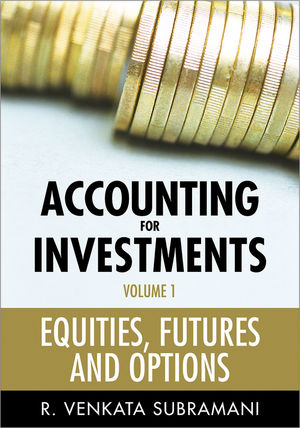Accounting for Investments, Volume 1: Equities, Futures and OptionsISBN: 978-0-470-82431-3
Hardcover
650 pages
June 2009
 This is a Print-on-Demand title. It will be printed specifically to fill your order. Please allow an additional 10-15 days delivery time. The book is not returnable.
|
||||||
Foreword xiii
Preface xv
Acknowledgments xxi
Chapter 1 Financial Instruments 1
Learning Objectives 1
Accounting Standards for Financial Instruments 1
Definition of Financial Instruments 2
Categories of Financial Instruments 3
Fair Value Measurement Concepts 4
Recognition and Derecognition of Financial Instruments 5
Types of Investments 5
Difference between Investment and Speculation 5
Two Major Standards: U.S. GAAP and IFRS 6
Summary 8
Exercises 9
Chapter 2 Accounting for Equity Investments: Trading 11
Learning Objectives 11
Accounting Standards for Equity Investments 11
Definition of Equity Securities 12
Passive Investments: Less than 20 Percent 13
Significant Influence: 20–50 Percent 15
Controlling Interest—More than 50 Percent 15
Exchange-Traded Securities versus Over-the-counter Securities 16
The Trade Life Cycle for Equity Trading Securities 16
FX Revaluation and FX Translation Process 33
Trade Date Accounting versus Settlement Date Accounting 39
Distinction between Capital Gains and Currency Gains 42
Summary 65
Exercises 67
Chapter 3 Accounting for Equity Investments: Available-for-Sale 75
Learning Objectives 75
Accounting Standards for Equity Investments: Available-for-sale 75
Basic Understanding of AFS 76
The Trade Life Cycle for Available-for-sale Equity 76
FX Translation on AFS Securities 79
Impairment of AFS Securities 79
Summary 114
Exercises 115
Chapter 4 Transfer of Categories 121
Learning Objectives 121
Transfer between Categories 121
Presentation in Income Statement 122
Deferred Tax Effects on Unrealized Gain/Loss 123
Summary 135
Exercises 136
Chapter 5 Equity Derivatives: Theory 141
Learning Objectives 141
Accounting Standards for Equity Derivatives 141
Derivatives in a Financial Security 142
Definition of Derivatives per Accounting Standards 143
Forward Contract 145
Futures Contract 145
Futures versus Forwards 146
Components of a Futures Contract 149
Open Interest in Derivatives Contracts 151
Method of Computing Open Interest 151
What Does Change in Open Interest Indicate? 152
Pricing of a Futures Contract 152
Stock Futures and Index Futures 152
Summary 153
Exercises 154
Chapter 6 Accounting for Equity Index Futures 159
Learning Objectives 159
The Trade Life Cycle for Equity Index Futures 159
Illustrations with FX Translation 165
Summary 212
Exercises 212
Chapter 7 Accounting for Equity Stock Futures 217
Learning Objectives 217
Trade Life Cycle for Equity Stock Futures 217
Illustrations 219
Summary 254
Exercises 254
Chapter 8 Accounting for Equity Call Options 259
Learning Objectives 259
Accounting Standards—Derivative Instruments and Hedging Activities 259
Trade Life Cycle for ETOs—Long Call Non-hedging 260
Illustrations 265
Trade Life Cycle for Exchange-Traded Options—On Writing a Call Option 288
Illustrations 293
Summary 302
Exercises 302
Chapter 9 Accounting for Equity Put Options 309
Learning Objectives 309
Trade Life Cycle for Exchange-Traded Options—Long Put, Non-hedging 309
Illustrations 315
Trade Life Cycle for Exchange-Traded Options—On Writing a Put Option 338
Illustrations 344
Summary 353
Exercises 353
Chapter 10 Equity Options: Hedge Accounting 357
Learning Objectives 357
Accounting Standards—Derivative Instruments and Hedging 358
The Trade Life Cycle for ETOs—Long Put as Hedging 365
Illustrations 372
Summary 412
Exercises 413
Chapter 11 Accounting for Contract for Difference 419
Learning Objectives 419
Definition of CFD 419
Product Features of CFDs 419
The Trade Life Cycle for CFDs 424
Illustrations 432
Summary 470
Exercises 471
Chapter 12 Accounting for Short Equity Investments 477
Learning Objectives 477
Definition of Short Equity Securities 477
Types of Short Sales 478
Process of Short-selling 478
Risks of Short-selling 479
Box Position and Short-selling 479
Rationale of Short-selling 480
Regulatory Requirements of Short Sales 480
Securities Lending 480
The Trade Life Cycle for Equity Short Sales 483
Illustrations 490
Summary 534
Exercises 536
Chapter 13 Accounting for ADR/GDR Investments 539
Learning Objectives 539
Definition of a Depositary Receipt 539
Issuance and Cancellation of DRs 540
DR Ratio and Pricing 540
Benefits of DRs to Issuers 540
Benefits to Investors 540
What are ADR and GDR? 541
Different Types of ADR Issues 541
Risks Associated with Investment in DRs 542
Restricted Programs 543
The Trade Life Cycle for Equity ADR Securities 543
Illustrations 549
Summary 575
Exercises 576
Chapter 14 Presentation and Disclosures 583
Learning Objectives 583
Accounting Standards for Presentation and Disclosure 583
Presentation in Income Statement 583
Differences between U.S. GAAP and IFRS 584
Disclosure Requirements under U.S. GAAP 586
Disclosure Requirements under IFRS 588
Requirements by IFRS 7 589
Statement of Profit and Loss and Equity 591
Other Disclosures 591
Market Risk 595
Summary 597
Exercises 598
Appendix A Basics of Accounting Theory 603
Appendix B Accounting Standards for Financial Instruments 609
Appendix C Financial Statements of Sample Fund 621
Appendix D Glossary of Technical Terms 631
Bibliography 641
Index 643



